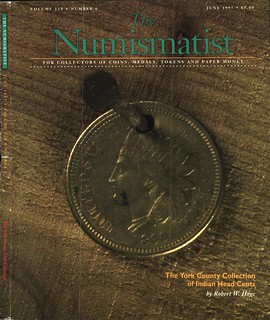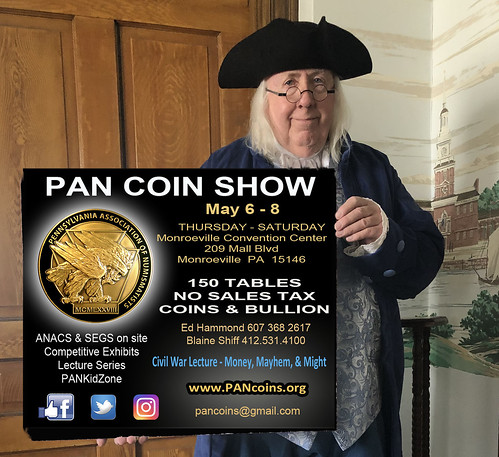
PREV ARTICLE
NEXT ARTICLE
FULL ISSUE
PREV FULL ISSUE
NOTES FROM E-SYLUM READERS: MAY 2, 2021Copper 1794 Dollar Pattern SalesDave Hirt writes:
"I was looking at the list of the former owners of the coin. It seemed curious to me that in 1890 it changed hands two times within six months, both times by the same company, New York Stamp and Coin. I pulled my catalog of the R. Coulton Davis sale, Jan. 1890. The obv. of the coin is plated on plate 3, but the plate is rather dark. David Proskey described the coin as "good for the period, unique." The coin realized $35. The buyer's name is listed as Lelay. I do not recognize that name. It may be in code. Just thinking, perhaps Parmelee was not the buyer, but another who returned the coin to NY because of condition. Then Proskey put the coin in the Parmelee sale in June 1890. He changed his description a bit to say "planchet not smooth." , which is consistent with the Heritage description as "excavated at the mint." The coin realized $20 in the Parmelee sale." Thanks! It's always interesting to trace the provenance of a coin and see whose hands it passed through over the years. Does "Lelay" ring a bell for anyone? I've come up empty in the Newman Portal. -Editor
To read the earlier E-Sylum article, see:
 Regarding the variety of the 1808 Half Dollar found while searching for one of Harriet Tubman's homes,
Brad Karoleff writes:
Regarding the variety of the 1808 Half Dollar found while searching for one of Harriet Tubman's homes,
Brad Karoleff writes:
"Looks like obverse 4 to me which would make it an Overton 104." Thanks! -Editor
To read the earlier E-Sylum article, see:
Special, or Limited Edition Red Books "Seeing as it's the 75th anniversary of the Red Book, I wondered if you could poll your subscribers to see if anybody has an updated list of Special, or Limited Editions. The trail ends for me in 2009 when Frank Colletti's "A Guide Book of The Official Red Book Of United States Coins" was published. I really wish Frank or someone else would update this book." I reached out directly to Dennis Tucker at Whitman Publishing. -Editor Dennis writes: "In Ken Bressett's upcoming A Penny Saved: R.S. Yeoman and His Remarkable Red Book we have a current listing of all Red Books including Limited Editions. "Frank Colletti's Guide Book of the Official Red Book of United States Coins goes into more depth as an edition-by-edition study . . . although, as Mr. Seldon notes, its coverage ends in 2009. "We do get quite a few queries from collectors who want an updated second edition of Frank's book. Pressure is building! I'll keep you and the NBS posted as we consider how to make that happen."
To read the earlier E-Sylum article, see:
From the Mountains of North Georgia, Harold Leviwrites:
"As a part of his business, Bill had purchased some amount of the British coins Robert Bashlow had gathered in his business. As a part of this, Bill had possession of several of the thin Bashlow Restrike Confederate cent pieces as well as a couple of the new Confederate cent pieces Bashlow and David Latise had made in London. He made me a great offer and I bought all. "My sincere condolences to his family. It is a little unsettling to find he and I were born in the same year." Thank you - great story; interesting connection. -Editor
To read the earlier E-Sylum article, see:
Ken Berger writes: "Regarding Ken Spindler's article about the holed Eight Reales coins. In The E-Sylum: Volume 11, Number 14, April 6, 2008, Article 11, you will find an article (More on Arras Tokens) by me explaining some of the reasons as to why the coins contain holes." Thanks. Here's Ken's description. See the article linked below for the initial discussion. -Editor "Yes, it is true arras are found in many weddings which have a Spanish tradition. I disagree however that they are always gold coins. The Philippines, for example, used silver coins. In the past these were primarily pesos. "The coins are supposed to be dropped from the groom's hands into the bride's hands in a 'more or less' cascading action. However, if any of the coins are dropped then bad luck is believed to be likely to occur in the marriage. In order to prevent such bad luck from occurring, the coins often had a hole drilled into them so a string could be passed through them & they could be tied together. These coins were to help the new couple with expenses as they started their life together. It is also possible that they were used as the lucky coins, one of which would be placed under each of the main pilings at each of the four corners of their newly-built house. "Thus, crown-sized coins with holes in them were possibly used in arras. However, it is also possible that they were worn as a piece of jewelry, or even served as teething rings. Ken adds: "I've thought of making an arras with 13 holed 8 Reales coins." "Regarding "The Holiest Coin Collection," Robert Hoge's article in The Numismatist of June, 1997 concerned a donation to the ANA Museum, of US small cents 1857-1879 gathered by a Pennsylvania farmer who pulled them from circulation, holed each one, and nailed each to his kitchen's wall. (The farmer died in early 1880.) "The front cover has a photograph of one of the coins." Cringeworthy for collectors, but interesting nonetheless. Thanks. -Editor
To read the earlier E-Sylum articles, see:
In response to a reader's question Pete Smith submitted these notes clarifying the difference between photos and portraits of early American coin collector Isaiah Quinby Lukens of Philadelphia. Thanks. -Editor There are at least four known pictures of Isaiah Quinby Lukens, two paintings and two daguerreotypes. The two daguerreotypes may be found among the image files at the Library of Congress. The first of these is attributed to photographer Robert Cornelius and taken about 1840-41. It can be identified by the oval mat around the image. The second was taken in 1842 and attributed to Paul Beck Goddard. It has an octagonal mat around the image. The image in the octagonal mat has been cropped into rectangular format and reproduced on at least three websites. 1. Numismatic Mall.com, undated. Attributed as [Fig, 1 Daguerreotype taken by Charles Wilson Peale]. 2. True West Magazine, article dated October 19, 2015. Attributed to "Charles Wilson Peale / Courtesy Library of Congress." 3. Colonial Quills, article dated February 28, 2018. Image attributed as "Isaiah Lukens daguerreotype by Charles Wilson Peale. All three have the middle name of Peale misspelled. Item #2 is a smaller image so it could not have been the source for #1 or #3. Since #3 is dated after #2, it could not have been the source. It looks like #1 was the source or there was another unidentified earlier source.
Then there is the missing link, a painting of Lukens done by Charles Willson Peale in 1816. It is located at the Franklin Institute in Philadelphia. Unfortunately, I could not find an image online. Any Google search for the Peale painting will turn up links to the other three images. Errors on the internet are frequently compounded through repetition. Once the Peale painting was confused with the Lukens photo, the error was repeated on the internet and this month in The E-Sylum.
To read the earlier E-Sylum article, see:
Bob Rhue writes:
"It comes on an extremely constricted planchet, with a diameter ranging from 5.0 to 5.4 mm. Normal diameter is 6.7 mm. "The Central portion of the thick Edge is raised around its entire circumference, sloping downward toward the rim on each side. "Because the peripheral lettering on both sides is sharp and undistorted yet significantly higher than the plane of the rest of the coin, my conclusion is that the planchet was upset subsequent to striking rather than prior to. In any event it seems clear that the bars used in the upsetting process were spaced much too closely during the production of this particular piece. "I welcome the opinion of others here. " Interesting item. What do readers think? -Editor Wayne Homren, Editor The Numismatic Bibliomania Society is a non-profit organization promoting numismatic literature. See our web site at coinbooks.org. To submit items for publication in The E-Sylum, write to the Editor at this address: whomren@gmail.com To subscribe go to: https://my.binhost.com/lists/listinfo/esylum All Rights Reserved. NBS Home Page Contact the NBS webmaster 
|










